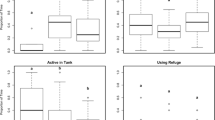Abstract
Individuals of two species of crayfish (Orconectes virilis andO. propinquus) were tested in the laboratory for responses to chemicals released from physically damaged conspecifics. Individuals ofO. propinquus did not show an alarm response to crushed conspecifics. Individuals ofO. virilis responded to a water-borne substance released from crushed conspecifics by assuming an intermediate posture and ceasing movement. Similar alarm responses were shown by individuals ofO. virilis to crushed congeneric individuals (O. propinquus), and these responses were not eliminated by either freeze-thawing the crayfish used to prepare the signal or by treating freshly crushed crayfish with the enzyme trypsin. Individuals ofO. virilis showed strong feeding responses to solutions prepared from frozen fish flesh but showed a mixture of alarm and feeding responses to freshly killed fish. These results indicate that the alarm substance used byO. virilis is widespread.
Similar content being viewed by others
References
Ameyaw-Akumfi, C.E. 1976. Some aspects of the breeding biology of crayfish. PhD thesis. University of Michigan, Ann Arbor, Michigan.
Fitzpatrick, J.F., Jr. 1987. The subgenera of the crawfish genusOrconectes (Decapoda: Cambaridae).Proc. Biol. Soc. Wash. 100:44–74.
Hazlett, B.A. 1985a. Chemical detection of sex and status inOrconectes virilis.J. Chem. Ecol. 11:181–189.
Hazlett, B.A. 1985b. Disturbance pheromones in the crayfishOrconectes virilis.J. Chem. Ecol. 11:1695–1711.
Hazlett, B.A. 1989. Additional sources of disturbance pheromone affecting the crayfishOrconectes virilis.J. Chem. Ecol. 15:381–385.
Hazlett, B.A. 1990a. Source and nature of the disturbance-chemical system in crayfish.J. Chem. Ecol. 16:2263–2275.
Hazlett, B.A. 1990b. Disturbance pheromone in the hermit crabCalcinus laevimanus (Randall, 1839).Crustaceana 58:314–316.
Hews, D.K. 1988. Alarm response in larval western toads,Bufo boreas: Release of larval chemical by a natural predator and its effect on predator capture efficiency.Anim. Behav. 36:125–133.
Hobbs, H.H., III 1993. Trophic relationships of North American freshwater crayfishes and shrimps.Contrib. Biol. Geol. Milwaukee Mus. 85:1–110.
Mathis, A., andSmith, R.J.F. 1993. Chemical alarm signals increase the survival time of fathead minnows (Pimephales promelas) during encounters with northern pike (Esox lucius).Behav. Ecol. 4:260–265.
McKillup, S.C., andMcKillup, R.V. 1992. Inhibition of feeding in response to crushed conspecifics by the pebble crabPhilyra laevis (Bell).J. Exp. Mar. Biol. Ecol. 161:33–43.
Pfeiffer, A. 1963. Alarm substances.Experientia 19:113–123.
Ressler, R.H., Cialdini, R.B., Ghoca, M.L., andKleist, S.M. 1968. Alarm pheromone in the earthwormLumbricus terrestris.Science 161:597–599.
Rittschof, D. 1980. Enzymatic production of small molecules attracting hermit crabs to simulated gastropod predation sites.J. Chem. Ecol. 6:665–675.
Rittschof, D., Tsai, D.W., Massey, P.G., Blanco, L., Kueber, G.L., Jr., andHaas, R.J., Jr. 1992. Chemical mediation of behavior in hermit crabs: Alarm and aggregation cues.J. Chem. Ecol. 18:959–984.
Smith, R.J.F. 1992. Alarm signals in fishes.Rev. Fish Biol. Fish. 2:33–63.
Snyder, N.F.R., andSnyder, H.A. 1970. Alarm response ofDiadema antillarum.Science 168:276–278.
Stenzler, D., andAtema, J. 1976. Alarm response of the marine mud snail,Nassarius obsoletus: Specificity and behavioral priority.J. Chem. Ecol. 3:159–171.
Tierney, A.J., andAtema, J. 1988. Behavioral responses of crayfish (Orconectes virilis andOrconectes rusticus) to chemical feeding stimulants.J. Chem. Ecol. 14:123–133.
Tierney, A.J., andDunham, D.W. 1982. Chemical communication in the reproductive isolation of the crayfishesOrconectes propinquus andOrconectes virilis (Decapoda, Cambaridae).J. Crust. Biol. 2:544–548.
Valenta, J.G., andRigby, M.K. 1968. Discrimination of the odor of stressed rats.Science 161:599–601.
Werner, E.E., andAnholt, B.R. 1993. Ecological consequences of the trade-off between growth and mortality rates mediated by foraging activity.Am. Nat. 142:242–272.
Wilkinson, L. 1988. SYSTAT, The System for Statistics. Systat, Inc., Evanston, Illinois.
Author information
Authors and Affiliations
Rights and permissions
About this article
Cite this article
Hazlett, B.A. Alarm responses in the crayfishOrconectes virilis andOrconectes propinquus . J Chem Ecol 20, 1525–1535 (1994). https://doi.org/10.1007/BF02059878
Received:
Accepted:
Issue Date:
DOI: https://doi.org/10.1007/BF02059878




